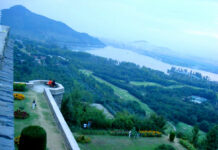Chief Secretaries of Punjab and J&K had a detailed sitting last week. The two states are running a festering dispute over water and Punjab has throughout been using every single moment to prove a selfishly bad neighbour. Punjab’s ambitious Ranjit Sagar Dam was actually built at the cost of J&K and the state was extending every possible help in the hope that it will get its due share. But it never was. J&K’s loss in helping Punjab has been upward of Rs 12000 crore.
Punjab and J&K have signed two agreements. The January 29, 1955 treaty shared the discharge from Ravi by giving J&K 0.65 million acre feet (MAF) over and above its pre-partition share of 0.04 MAF from the Ravi and the Beas rivers. Punjab started implementing Thein (Ranjit Sagar) dam in 1957.
Almost six years after, J&K started drawing 0.215 MAF using the Kathua canal. The balance share of 0.475 MAF, according to 1955 agreement was to be supplied partly (0.285 MAF) from free flow supplies and partly (0.19 MAF) from storage of Ravi water. But lifting from storage was possible only after Thein Dam was set up.
As Punjab started the spade work, J&K in 1975 started constructing 82 Kms long Ravi Canal between the proposed dam and Vijapur for taking water to the end user.
After Punjab settled its issues with Himachal, the project required J&K to do more as the dam site fell in Thein belt of J&K where 22 villages lived. This necessitated second agreement on January 20, 1979. It promised J&K a basketful of benefits. J&K was taken as a partner and it was asked to invest in the canal network that had the capacity to take 0.69 MAF water. It was given rights over 20 percent of the generations at bus-bars and 15 percent share in all jobs that the project generates. Affected population was to be compensated and rehabilitated by Punjab and the areas inundated or the roads damaged were to be aligned by.
As Thein was set up, J&K waited for a long time for its share of the benefits. They never came. As J&K insisted for the water share (1150 cusecs), they were told it would happen after Shahpur-Kandi barrage, a small storage unit at the tail end of the project, comes up. The situation turned grim after Punjab managed passage of controversial Punjab Termination of Agreements Bill, 2004 on July 12, 2004 annulling the December 31, 1981 agreement between Punjab, Haryana and Rajasthan relating to the Ravi and Beas waters. It eventually landed in the apex court which arrayed J&K as a party.
Even though Punjab submitted an affidavit to the SC saying their law does not envisage its treaty with J&K, Srinagar government is not willing to move forward. As Punjab is desperate to revive the relationship, its credibility is at stake.
Last summer, its officials drove deep into J&K territory and encroached upon almost 3000 kanals of land. Forced by the local farming community, the government sent its officials, dismantled the structures Punjab had created into J&K and pushed them back.
In the last meeting, Punjab delegation was told in categorical terms that if Punjab wants any forward movement, there has to be a fresh agreement between the two states. J&K even has strong reservations over the design of the Shahpur-Kandi barrage in which the crest level on Kathua side is double than that of Gurdaspur. This was possibly done to prevent any movement of water mandated by the treaty to J&K.
In such a situation, the government must debate the issue in the assembly and come out with a stand on basis of which Punjab needs to be engaged. Right now when Delhi has declared it a project of national importance, making Punjab get free money, J&K must assert its rights to prevent what has happened in the past.









